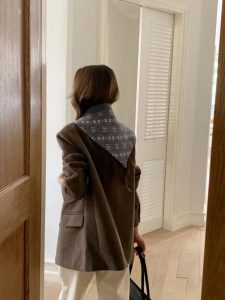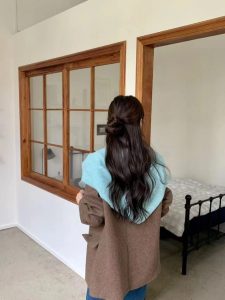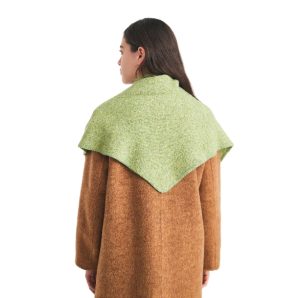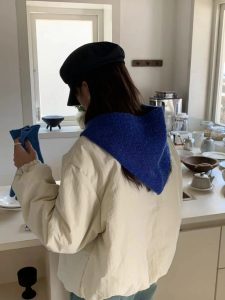Handmade vs Machine-Made Wool Triangle Scarves
Ever wrapped yourself in a wool triangle scarf on a crisp fall morning and felt that instant coziness? Yeah, those pieces aren’t just add-ons—they’re like a hug from your closet. But here’s the deal: not all wool triangle scarves come the same way. Some get made by folks’ hands, one stitch at a time. Others come off quick machines in big plants. If you’re out shopping for one, or stocking your shop, getting the handmade versus machine-made thing can really help. We’ll dig into it here, from how they get put together to what fits your vibe or needs. Hang tight; you might spot your next go-to wrap.
What Makes Wool Triangle Scarves So Special?
Let’s start with the basics. Wool triangle scarves are those handy, three-sided items that hang nicely around your neck or shoulders. You can even use them as a bandana head wrap. They get made from wool, often mixed with some polyester for toughness. They hit that nice spot between keeping you warm and letting air through.
Why pick wool? It’s a natural stuff that’s been used forever. It pulls sweat away from your skin and holds in heat. And the triangle form? It’s super useful. Tie it up for a neat neck look. Or let it hang loose for a free style. I have one in matcha green that I toss on with jeans and a shirt—it changes the whole outfit.
But beyond that, the key is how they’re made. Handmade ones have a personal feel, like a tale in the yarn. Machine-made? They’re about being the same every time and fast. Both work well in their own way. But knowing the gaps lets you choose smart.
Diving into Handmade Wool Triangle Scarves
Handmade wool triangle scarves seem like they come from old times, right? Workers pick raw wool yarns, often from spots like Inner Mongolia for top-notch stuff. It starts with choosing fibers—long, smooth ones to skip any scratchy feel. Then they knit or crochet by hand. Picture a worker with needles or a hook, looping yarn into shapes like simple lines or light edges.
Look at the sides, for one. In handmade items, those fringes get twisted one by one. That gives a special, not-so-perfect wave. It’s not all the same; each scarf might differ a bit in how tight the stitches are or how deep the colors go. That’s because people do it, not robots. And that’s what makes them cool. Numbers from craft sales show handmade goods can sell for 20-30% more because of that rare feel—folks love having something no one else has just like it.
What are the upsides? They’re tough in a heartfelt way. The hand-knitting makes a looser pattern that lets air in better. It’s great for piling on without feeling heavy. Plus, they often use better wool, like 10% wool mixed with polyester for a gentle touch without losing heat. If you run a small store and want stuff for your shelves, handmade might mean not much in stock. But you’ll get repeat buyers who talk up the goodness.
Here’s a fun bit: workers sometimes add in local designs, like flower shapes from the outdoors. It’s not just cloth; it’s wearable art.
And let’s break down the process a little more. First, they sort the yarn by hand. They check for any rough spots. Then, they dye it if needed, using safe colors that stick well. After that, the actual making begins. It could be knitting in rows or crocheting loops. Each step gets checked by eye. No tech involved there. This hands-on way means fewer mistakes that feel wrong, but more that add character. Like, a slight pull in the yarn might make a unique spot. Some folks see that as a flaw. Others? They call it charm. I’ve chatted with artisans at fairs, and they say it’s about feeling the material. You can’t get that from a screen.
Exploring Machine-Made Wool Triangle Scarves
Switch over to machine-made now. These scarves come from places with big looms run by computers. It begins kind of the same—picking yarn, often good wool mixes. But then machines jump in. Think of smart weaving tools that make detailed shapes with exact spots. No shaky sides here; all looks even.
Speed is the big win. One machine can spit out many in a day. That keeps prices low. Reports from the cloth world say machine making is 5-10 times quicker than by hand. So you can grab one cheap. And the goodness? Don’t dismiss it. New tools make sure stitches are steady, colors don’t vary, and the end looks pro. For example, a machine-made wool triangle scarf in plain matcha green might weigh about 120g. It’s sized at 95x95x160cm—same every go.
The good side: you can make lots. If you have an online shop, machine-made lets you fill up fast without long waits. They’re also simple to clean—less likely to catch on things because the pattern is tight. I own a machine-made one that’s gone through washer cycles (but hand wash is still smarter). Downsides? They might miss that handmade warmth. Shapes can seem the same over and over.
Interesting point: some places mix tech and old ways. They use machines for the main part and hands for the ends. It’s like a combo out there.
Let me add a bit more on how it works. Machines get set up with programs. They tell it what pattern to follow. Yarn feeds in automatically. Rollers pull it through. Heat and pressure set the shape. Then cutters trim edges clean. It’s all quick and clean. But sometimes, if the yarn isn’t perfect, you get issues like uneven dye. Factories test batches though. They run checks at each stage. That keeps most problems out. I’ve visited a couple of these spots—loud, but impressive. Rows of machines humming away. It’s efficient, no doubt.
Key Differences: Handmade vs Machine-Made at a Glance
How do they compare? Let’s put it out straight. I’ve made a simple chart from what I’ve seen in the trade—straight talk from sellers and buyers.
|
Aspect |
Handmade Wool Triangle Scarves |
Machine-Made Wool Triangle Scarves |
|
Production Time |
Days to weeks per piece |
Hours per batch |
|
Cost |
Higher (premium craftsmanship) |
Lower (efficient scaling) |
|
Uniqueness |
Each one-of-a-kind |
Consistent and uniform |
|
Durability |
Flexible weave, ages gracefully |
Tight weave, resists wear |
|
Feel & Texture |
Softer, more breathable |
Smooth, professional finish |
|
Eco-Factor |
Often uses sustainable sourcing |
Can be mass-produced sustainably |
Handmade stands out for custom stuff—nice for gifts or special spots. Machine-made takes it on steadiness, good for regular use or big buys. Stats from cloth research support this: handmade scarves get better marks in polls for “heart value.” But machine ones lead in how many sell.
To expand on this, think about eco stuff. Handmade often comes from small groups. They pick green yarns, like recycled bits. Less waste too, since they make less. Machine-made can go green if the plant uses clean power. Some recycle water in dyeing. But big runs mean more stuff overall. It’s a balance. I’ve read reports where handmade scores higher on low impact. Yet machines can cut down on labor waste. Depends on the maker.
Choosing the Right Wool Triangle Scarf for You
Okay, time to pick. It comes down to what you want. If you seek something standout, like for a wedding or a bold look at parties, choose handmade. That worker touch lifts your clothes—imagine it over a gown at an art show. But for daily trips or filling shop racks, machine-made fits. They’re useful, cheap, and always ready.
Think about your day-to-day too. Got kids and always rushing? Machine-made won’t need fancy care. Love making things? Handmade lets you value the work. And me? I switch it up—handmade for lazy days, machine for jobs. Tip: look for stamps like OEKO-TEX. They mean it’s kind to skin, no matter what.
One more thing I’ve found? Mixes matter. A 10% wool blend stays light but cozy. It skips that bulky pure wool sense.We can also produce 100% pure wool products according to the customized requirements of our customers.
Let’s list out some tips for choosing:
- Check the weight: Lighter for spring, heavier for cold snaps.
- Feel the fabric: Rub it on your hand. Should be smooth, not rough.
- Ask about wash: Can it go in the machine? Or dry clean only?
- See the colors: Do they match your clothes? Solids are safe; patterns add fun.
- Think budget: Handmade for splurges, machine for saves.
I’ve helped friends pick, and these points always help. One buddy got a handmade for her mom—big hit. Another stocked machine ones for her store—sold out quick.
She Believes: Your Trusted Wool Triangle Scarf Supplier
Talking about good places, let’s spotlight She Believes. They’ve been in the shawl and scarf world for over 15 years. They focus on wool triangle scarves with nice mixes like wool and polyester. It’s for that right mix of heat and gentleness. Out of Yiwu, China, they back women business owners with easy choices—small runs, quick tests, and full service for world brands. Their luxury knit matcha green wool triangle scarf stands out: 95x95x160cm, 120g, in shades from beige to chocolate brown. With papers like GRS and ISO 9001, they make sure each item hits high marks, be it hand details or machine accuracy. If you want wholesale or custom, they’re solid for reliable, women-boosting ties.
I recall checking their site once. Lots of options, clear info. Makes ordering simple.
Conclusion
To sum it up—pun there—handmade and machine-made wool triangle scarves each offer their own thing. Handmade brings that special worker flair and skill. Machine-made gives speed and sameness without cutting corners on goodness. In the end, your pick ties to what lights you up in your clothes or helps your work. Either one, a solid wool triangle scarf is beyond cloth; it’s a trusty pal for cool times. If you’re looking at one, weigh stuff like toughness, touch, and where it comes from— it’ll give back in ease and look.
And hey, don’t rush the choice. Try a few. See what sticks.
FAQs
What’s the main difference between handmade and machine-made wool triangle scarves in terms of quality?
Handmade wool triangle scarves often have special feels from worker methods, like twisted fringes by hand. They can breathe more and feel personal. Machine-made ones have even stitches and steady colors from smart tools. That makes them tough for regular wear. Both can be top-notch if from good spots. But handmade might win on that rare vibe.
Are handmade wool triangle scarves worth the extra cost compared to machine-made ones?
Sure, if you want something unique—like custom shapes or old designs that share a tale. They might cost 20-30% more from the time put in. But for big days or gifts, it’s worth it. Machine-made wool triangle scarves give solid bang for your buck on big buys or daily stuff. They keep prices down but hold the heat and style.
How do I care for handmade vs machine-made wool triangle scarves to make them last?
For both, dry cleaning works best to keep the form. But hand wash in cool water is okay too—just don’t twist hard. Handmade might want softer handling to stop pulls. Machine-made forgive more with their close patterns. Dry flat in shade, store folded; a light steam on low freshens them up.
Can I customize wool triangle scarves, whether handmade or machine-made?
Yeah, lots of places let you change colors or shapes. For handmade wool triangle scarves, custom adds a close feel but needs more days—say 7-10 for tests. Machine-made scale quick for big lots, great for adding marks or set sizes.
Which is more eco-friendly: handmade or machine-made wool triangle scarves?
It hangs on where they get stuff. Handmade often uses green, small lots from fair places. That cuts waste. Machine-made can be kind too, specially with stamped plants that save power. Seek mixes with reused fibers—both ways can fit green ideas if the maker cares.






